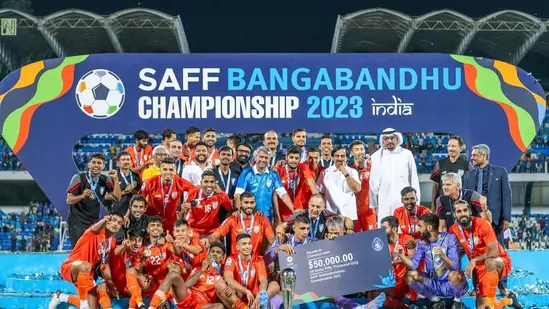Indian football is finding its feet
Two tournaments, two titles and a return to the top 100 in FIFA rankings. Nine games, which is one more than what India played in all of 2022, in 26 days. Seven wins and two draws, seven clean sheets. That was the India story in the Intercontinental Cup and the SAFF Championships. Here’s looking at some of the reasons that produced such a strong performance.

Long preparatory camps
It is the thread that binds successive India coaches from Bob Houghton to Igor Stimac and includes in its loop Wim Koevermans and Stephen Constantine. It is necessary because international football is almost always a step up from the standard at home. Under Stimac, India have improved with every game in a competition when they trained together for four weeks or more. It happened in the 2019 Asian Cup under Constantine as well.
And it did in the final round of the Asian Cup qualifiers in 2022 in Kolkata; India playing their best against Hong Kong. From the first minute when Anwar Ali scored to the goal in 90+3 by Ishan Pandita, India were relentless in pushing Hong Kong on a wet evening at Salt Lake stadium.
Twice in Bengaluru, Gurpreet Singh Sandhu spoke about the importance of being together for over seven weeks since assembling in Bhubaneswar before the Intercontinental Cup. Anirudh Thapa has said players need time to adjust from ISL and the presence of foreign players. Also, players are often used in different positions at the clubs from where they play in the national team – used as a left-back by Bengaluru FC in 2021-22, Ashique Kuruniyan is India wide left – and they need time to adjust, said Thapa. Newbies such as Mahesh Naorem too need time to bed-in and get players around him to understand what he does best, said Thapa. Lallianzuala Chhangte’s equaliser in the final was proof of a team preying together because they were staying together.
Having lost his place in the Bengaluru FC starting line-up in the second half of the 2022-23 ISL, Sunil Chhetri wasn’t in his element at the start of the three-nation meet in Imphal last March. By the time the Intercontinental Cup came around, after three weeks of training, he had regained his mojo. But with there being no time after this for long camps, it will have to be seen how India cope in competitions leading up to the Asian Cup and in that tournament.
Stronger and fitter
Luka Radman, India’s strength and conditioning coach, has worked with the Croatia national team in the 1998 World Cup and their men’s basketball team that won silver in the 1992 Olympics. He has been with the India team as part of Stimac’s staff since 2019 and the results are showing. While Kuwait and Lebanon were visibly tired, no Indian player was. “For the first time, I saw an Arab team wasting time,” Thapa said in an interview to HT before the final. After Tuesday, he could add Kuwait to the list. “They were playing for penalties,” said Sandhu in the flash interview after India won.
Ask Chhetri and he will tell you that no player is embarrassed to take his shirt off. Stimac rotated the squad to get through games but India’s sprints, recovery runs and energy levels stayed consistently high. This too has been a gradual process and has been helped by the overall improvement in monitoring fitness at ISL clubs but rarely, if ever, have the squad been this fit and strong.
Attitude is everything
Mahesh Naorem is said to be very media-shy. But three months into his India career, he is seen chirping away at referees, hands clasped at the back. Chhetri, who will be 39 in August and has signed a new deal at Bengaluru FC, has been sprinting to the referee to protect teammates. Of course, playing at home and backed by a boisterous crowd in Bengaluru had something to do with this but this is an India that won’t back down. “If you are hitting us, we will also hit you,” Thapa has said.
The feeling of being overawed has ebbed with time, more internationals and playing with and against imports at home. And will be important going into next January’s Asian Cup. Against teams at their level or slightly higher, India want the ball and are willing to set up a high defensive line. They also have players who can take penalties with brio and win a semi-final and final without the head coach in the technical area.
But aggression can be a double-edged sword and India overdid it in the SAFF Championships where Stimac was sent off twice and Rahim Ali let petulance get the better of patience.
Work in final third
The clean sheets were a measure of defensive durability. Players are tracking back oftener, making Kuruniyan not doing that on Tuesday an exception that proves the rule. Rohit Kumar, Jeakson Singh and Thapa have been crucial in protecting the back four and the goalies making India difficult to break down. True, tests way tougher lie ahead (and in foreign lands) but in both tournaments India could significantly cut down the frequency of big chances against them.
Decisions in the final third though need a lot of work. India also need to improve their goals-for-chances ratio. From 2019, Stimac has spoken of the need for other players to step up but the burden of scoring is still largely Chhetri’s.
Disclaimer: The copyright of this article belongs to the original author. Reposting this article is solely for the purpose of information dissemination and does not constitute any investment advice. If there is any infringement, please contact us immediately. We will make corrections or deletions as necessary. Thank you.







